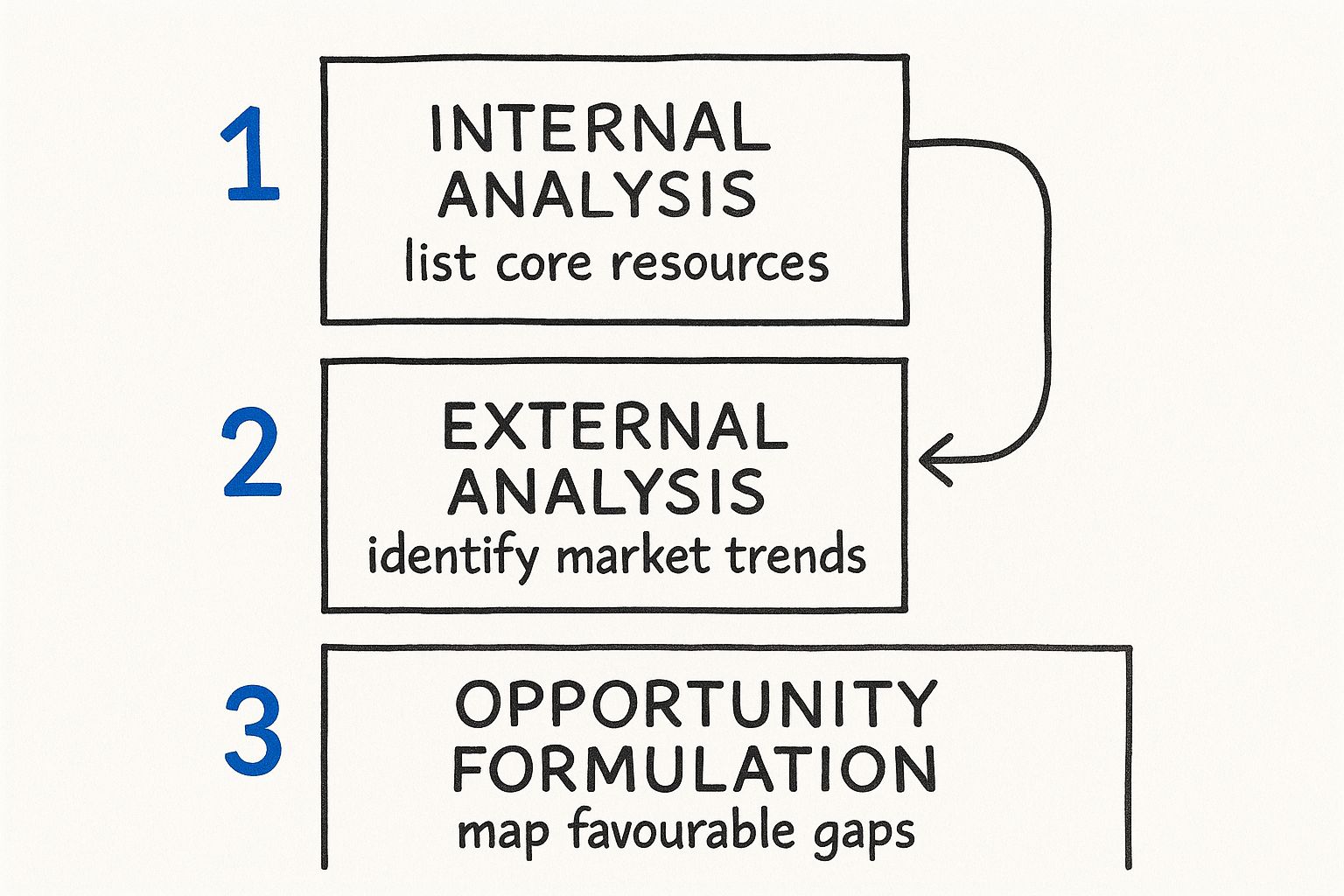Business Innovation Models: Drive Growth & Stay Competitive
Oct 7, 2025 in Guide: Explainer
Explore top business innovation models with real examples. Learn to select and apply frameworks that boost growth and keep you ahead.
Not a member? Sign up now
NILG.AI on Oct 6, 2025
Alright, let’s get down to it. A SWOT analysis isn’t some complex, high-level business school exercise. At its heart, it’s about taking a brutally honest look at your company to figure out what’s really going on. It’s a framework for mapping out your internal Strengths and Weaknesses, and then looking outside your walls to spot potential Opportunities and lurking Threats.
Think of a SWOT analysis as your business’s compass, not just another checklist to tick off. For a specialized company like an AI or data consultancy, it’s the difference between guessing your next move and making a truly strategic one. It forces you to get a complete picture of your operation, highlighting what you’re great at and where you’re exposed.
This kind of clarity is gold. It helps you tackle the big questions that will define your future.
To really wrap your head around this, it helps to see the four quadrants laid out simply. This little table breaks down what each part of the SWOT analysis is all about.
| Quadrant | Focus Area | Key Question to Ask |
|---|---|---|
| Strengths | Internal & Positive | What do we do exceptionally well? What are our unique assets? |
| Weaknesses | Internal & Negative | Where are we falling short? What holds us back? |
| Opportunities | External & Positive | What market trends or changes can we take advantage of? |
| Threats | External & Negative | What external factors could harm our business? |
This table is your starting point. It’s the “what” of the analysis. The rest of this guide will walk you through the “how.”
The beauty of the SWOT framework is its timeless simplicity. It’s been around since the 1960s, but it’s anything but dated. It started in the corporate world, but now you’ll see it used for everything from hashing out AI ethics to city planning.
Modern versions are even incorporating things like ESG (Environmental, Social, and Governance) factors and real-time data to stay relevant. It’s a testament to its staying power. If you’re curious about its modern applications, you can read more about how SWOT analysis is used today on AMRA & ELMA.
A good SWOT analysis forces you to face the music. It’s the bridge between where you are today and where you want to be tomorrow, giving you the raw, honest insights you need to build a real strategy.
When you nail down these four areas, you can start building a plan that actually works. A plan that leans into your strengths, patches up your weaknesses, jumps on opportunities, and puts up a solid defense against threats. This is the first step to making your SWOT analysis a living document that fuels growth, not just another file collecting dust on a server.
Let’s be real: a powerful SWOT analysis doesn’t just happen because you book a conference room and grab a whiteboard. The magic is in the prep work. If you want genuine, game-changing insights, you have to intentionally create an environment for them. This means getting the right people involved and grounding the whole conversation in hard data, not just gut feelings.
Your first move is assembling the right team. This isn’t a C-suite-only exercise. To get a true 360-degree view, you need voices from every corner of the business. Think about it:
Bringing these different perspectives together is your best defense against groupthink. It ensures your SWOT reflects the reality of the whole organization, not just the view from the executive suite.
Once you’ve got your team, the next crucial step is making sure everyone feels safe enough to be brutally honest. A SWOT analysis is useless if people are afraid to point out the weaknesses. You have to explicitly state that the goal is to get better together, not to point fingers.
The most productive SWOT sessions I’ve been a part of were the ones where every idea was on the table and all feedback—good or bad—was treated as a gift. It’s not about personal performance; it’s about getting strategically sharp.
Before you even start, lay down some ground rules: no interruptions, no shooting down ideas, and a strict focus on the issues, not the people. This is how you get someone to finally speak up about that persistent project bottleneck or a critical skills gap without worrying about blowback.
A SWOT based on feelings is just a glorified guessing game. A SWOT backed by data? That’s where the real strategy begins. Before the meeting, give people homework. Task specific team members with pulling key metrics so your discussion is anchored in reality.
Here’s a quick list of what you should gather:
It’s also incredibly helpful to gauge whether your team is even ready for this level of self-reflection. Understanding their mindset is a key part of the prep work. You can get a deeper look into this with a change readiness assessment. Walking into the room with this kind of information is the difference between making vague complaints and identifying concrete, solvable problems.

Okay, you’ve got the right people in the room and the data is ready. Now comes the internal deep-dive. This is where you take a hard, honest look in the mirror to figure out your real strengths and weaknesses—the stuff that’s happening inside your own walls, completely within your control.
The point here isn’t to create a feel-good laundry list or a catalog of complaints. It’s about painting an unflinchingly realistic picture of what your business can and can’t do right now.
Get this self-assessment right, and your whole strategy will be built on solid ground, not just wishful thinking.
When people start brainstorming strengths, the first things that pop up are usually clichés like “a great team” or “strong company culture.” Sure, those things are nice, but they’re not specific enough to build a strategy around. You have to dig a lot deeper to find the unique advantages that actually set your AI and data consulting business apart from the pack.
Think about the concrete assets and processes that give you a legitimate edge. These are the things a competitor would have a hard time copying.
To get past the generic fluff, try asking your team questions like these:
These are the kinds of specific, measurable strengths you can actually build on. They’re the weapons you’ll use to go after opportunities and fend off threats.
Let’s be real—this is usually the toughest part of the whole exercise. Pinpointing weaknesses takes some serious honesty and a room free of egos. It’s not about pointing fingers; it’s about spotting the organizational cracks that could hold you back or leave you exposed.
And just like with strengths, vague statements are useless. “Poor communication” is a symptom, not a diagnosis. You have to dig into the why to find something you can actually fix.
Admitting a weakness is the first step to turning it into a future strength. It’s far more dangerous to ignore a vulnerability than to name it and create a plan to address it.
The best way to navigate these tricky conversations is to focus on tangible business challenges. For an AI and data consulting firm, here are a few questions to get the ball rolling:
Identifying a weakness like “our junior data scientists need so much hand-holding that they slow down our senior staff” is infinitely more useful than a generic bullet point. It’s specific, you can measure its impact, and it gives you a clear problem to solve. This kind of honest internal audit is what gives you the clarity to know what you’re truly capable of.

Alright, you’ve done the internal work. Now it’s time to look outside your own four walls.
The second half of a SWOT analysis is all about scanning the world around you—your market, your industry, the whole nine yards—to pinpoint the Opportunities and Threats lurking out there. These are the external forces you can’t control but absolutely have to react to.
Think of it this way: you can’t change the weather, but you can check the forecast and decide whether to bring an umbrella or sunglasses. This is where your analysis shifts from self-reflection to pure market intelligence.
Opportunities are those golden external conditions that could give your business a serious leg up. But these aren’t just pie-in-the-sky ideas; they’re tangible shifts or gaps in the market you’re perfectly positioned to jump on.
For a firm in the AI and data world, these often pop up from new tech or changing rules. You have to get more specific than just “AI is growing.” Real opportunities are ones you can act on.
To really nail this part, you need to go beyond a quick Google search. This is about conducting thorough market research to turn vague feelings into a concrete list of potential growth plays.
Threats are the external factors that could put your business in a tight spot. Ignoring them is like sailing into a storm without even glancing at the weather report.
Spotting them early gives you a chance to build defenses, adjust your course, or maybe even figure out how to use the storm to your advantage.
And just like with opportunities, “more competition” is way too vague to be useful. What kind of competition?
To help you get your head around the difference between what’s happening inside versus outside your company, here’s a quick breakdown.
| Factor Type | Description | Example for an AI Consulting Firm |
|---|---|---|
| Internal (You Control) | Your company’s own resources, processes, and people. | Strength: A proprietary algorithm that outperforms competitors. Weakness: A small sales team struggling to keep up with leads. |
| External (You Don’t Control) | Market trends, economic shifts, and competitor actions. | Opportunity: New government funding for AI adoption in healthcare. Threat: A smaller, specialized competitor undercutting your prices on specific services. |
This clear distinction is what makes a SWOT analysis so powerful.
Modern businesses have to use data to make this process truly effective. Consider this: over 60% of firms report facing threats from technological disruption like new AI, while at the same time, 55% see huge opportunities in AI-powered personalization. Bringing in hard numbers like these elevates your SWOT from a subjective brainstorm to a strategic, evidence-based plan.
By anticipating what’s coming, you can better prepare. Sometimes, you might even find that what first looked like a threat is actually a hidden opportunity. Learning how AI can turn your business risks into opportunities is a game-changing mindset that starts right here.
So you’ve filled out all four quadrants. Great. But an analysis without an action plan is just a well-organized list of things you already kind of knew. Now for the most important part: turning those observations into a real-world strategic roadmap. This is where your hard work actually starts to pay off and drive real growth.
A powerful way to bridge that gap is by using a TOWS Matrix. It sounds a bit jargony, but it’s really just a straightforward method for connecting the dots between your quadrants. Instead of looking at Strengths, Weaknesses, Opportunities, and Threats in isolation, you start pairing them up to spark strategic ideas.
This is all about asking the right questions to link everything together.

The graphic above really boils the process down. You take your internal and external analysis and use it to build tangible opportunities.
By pairing up the different quadrants, you can start to develop four distinct types of strategies. I’ve found this structured approach is key—it ensures you’re proactively planning your next moves instead of just reacting to whatever comes your way.
Let’s walk through how this works for a hypothetical AI consulting business.
The goal isn’t just to list these pairings. It’s to generate a handful of high-impact, actionable initiatives that you can genuinely pursue.
You’re probably looking at a long list of potential actions now. The final step is to hammer that brainstorm into a concrete plan. This means prioritizing ruthlessly, assigning ownership, and defining what success actually looks like.
First, prioritize. Let’s be honest, not every idea is a winner. For each potential action, think about its potential impact versus the effort it’s going to take. Once you have a shortlist, a logical next step might be a comprehensive feasibility study for your top one or two initiatives.
Next up, assign clear ownership. Every single action item needs a name next to it—a single person responsible for pushing it forward. Without an owner, even the best ideas die on the vine.
Finally, set clear timelines and measurable KPIs. “Launch new service” isn’t a goal; it’s a wish. “Launch AI Compliance Audit service by Q3, securing three pilot clients and generating $150k in pipeline“—now that’s a goal.
This whole process is what transforms your SWOT from a static document gathering dust into a living guide that actively supports your journey toward smarter, data-driven decision-making.
Even with the best instructions, you’re bound to have questions once you start digging into a strategic exercise like this. It happens every time. So, let’s go over some of the most common questions that pop up when teams are getting the hang of SWOT analysis. Getting these answers down can save you from a lot of common headaches.
There’s no magic number here, but a solid rule of thumb is to do a full-blown, deep-dive SWOT analysis once a year. This usually lines up perfectly with annual strategic planning.
However, if you’re in a fast-paced industry like AI and data consulting, you can’t afford to wait a whole year. For sectors like that, I strongly recommend a lighter quarterly check-in. This keeps you on your toes and lets you spot new threats or jump on fresh opportunities before they pass you by.
Think of it as an annual physical for your business, with quick quarterly check-ups to make sure your strategy is still in good shape.
The single most common trap is being vague. Hands down. A laundry list of generic points like “strong brand” or “good team” is basically useless. It’s a waste of everyone’s time.
What does “strong brand” even mean? A much better Strength is something specific and measurable, like: “Our blog ranks in the top 3 for ‘AI strategy consulting,’ generating 20 qualified leads per month.” See the difference? Specificity is everything.
The runner-up for the biggest mistake? Letting the finished analysis collect digital dust. If your SWOT doesn’t immediately feed into an action plan with real owners and deadlines, you just went through the motions for nothing.
Absolutely! The SWOT framework is way more flexible than people think; it’s not just for massive, company-wide strategy sessions. You can use the exact same logic to size up a new marketing campaign, a potential product line, or even just the performance of your sales team.
It’s a fantastic tool for getting everyone on the same page and achieving real clarity before you kick off a big project. Applying it on this smaller scale helps ensure all your individual initiatives actually line up with the bigger picture by forcing you to consider the internal and external forces at play for that specific effort.
A great SWOT analysis gives you the clarity to turn your biggest challenges into your next big growth opportunities. At NILG.AI, we specialize in building the AI-powered solutions that make your strategic action plan a reality. Request a proposal
Like this story?
Special offers, latest news and quality content in your inbox.
Oct 7, 2025 in Guide: Explainer
Explore top business innovation models with real examples. Learn to select and apply frameworks that boost growth and keep you ahead.
Oct 6, 2025 in Listicle: Round-up
Discover 10 actionable digital transformation best practices. Learn how to drive growth with strategic insights for AI and data-focused businesses.
Oct 6, 2025 in Guide: How-to
Learn how to conduct SWOT analysis with this practical guide. Get actionable strategies, real-world examples, and proven tips for strategic business planning.
| Cookie | Duration | Description |
|---|---|---|
| cookielawinfo-checkbox-analytics | 11 months | This cookie is set by GDPR Cookie Consent plugin. The cookie is used to store the user consent for the cookies in the category "Analytics". |
| cookielawinfo-checkbox-functional | 11 months | The cookie is set by GDPR cookie consent to record the user consent for the cookies in the category "Functional". |
| cookielawinfo-checkbox-necessary | 11 months | This cookie is set by GDPR Cookie Consent plugin. The cookies is used to store the user consent for the cookies in the category "Necessary". |
| cookielawinfo-checkbox-others | 11 months | This cookie is set by GDPR Cookie Consent plugin. The cookie is used to store the user consent for the cookies in the category "Other. |
| cookielawinfo-checkbox-performance | 11 months | This cookie is set by GDPR Cookie Consent plugin. The cookie is used to store the user consent for the cookies in the category "Performance". |
| viewed_cookie_policy | 11 months | The cookie is set by the GDPR Cookie Consent plugin and is used to store whether or not user has consented to the use of cookies. It does not store any personal data. |